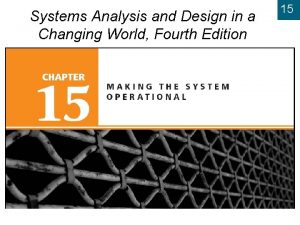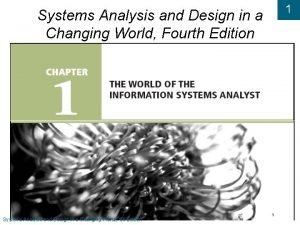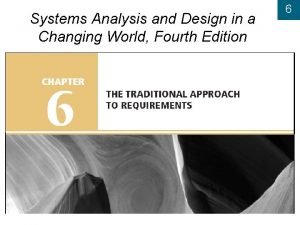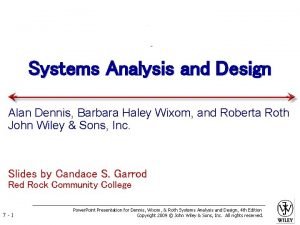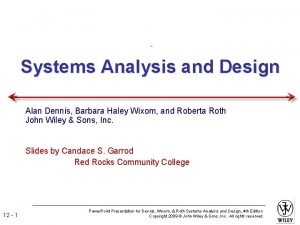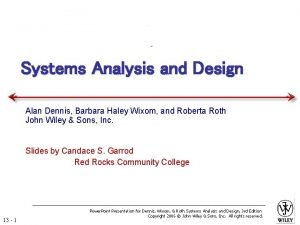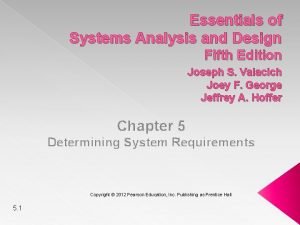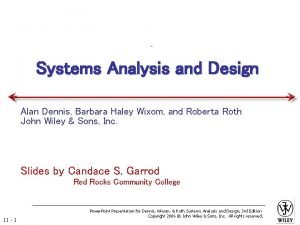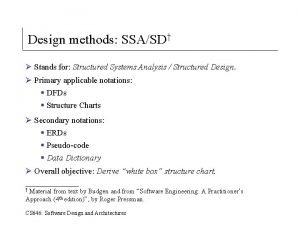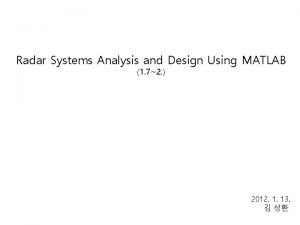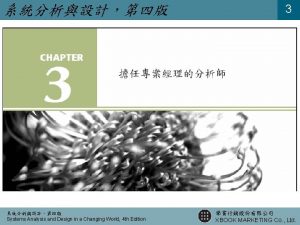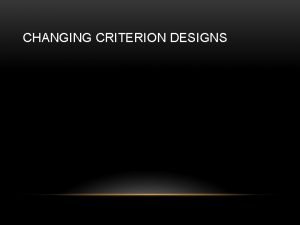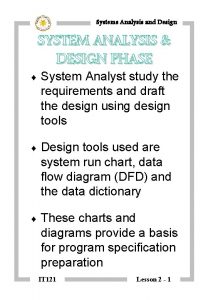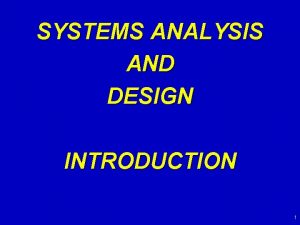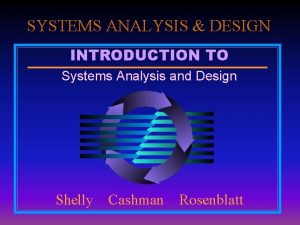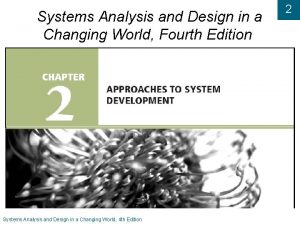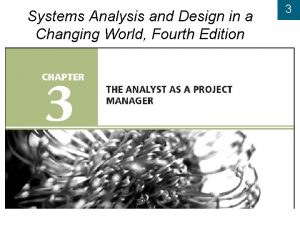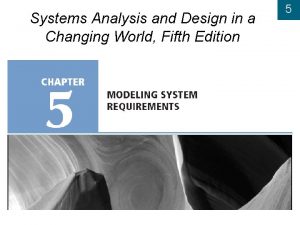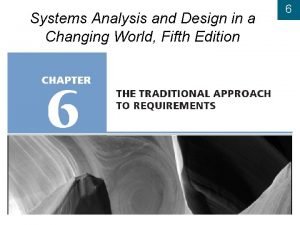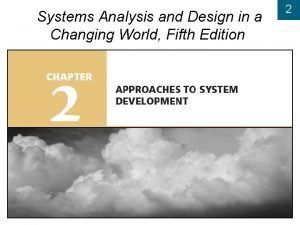10 Systems Analysis and Design in a Changing










































- Slides: 42

10

Systems Analysis and Design in a Changing World, Fourth Edition 10

Learning Objectives 10 u Describe the steps involved in the traditional approach to designing the application architecture u Develop a system flowchart u Develop a structure chart using transaction analysis and transform analysis u Write pseudocode for structured modules u Explain how to use three-layer design with the traditional approach Systems Analysis and Design in a Changing World, 4 th Edition 3

10 Overview u Traditional approach to designing software l Overview of structured models, model development process, related terminology l How data flow diagrams are annotated with automation boundary information l How analysis phase models are transformed into design models using system flowcharts, structure charts, and module pseudocode l Integration into other design phase activities l Applying approach to a three-layer architecture Systems Analysis and Design in a Changing World, 4 th Edition 4

The Structured Approach to Designing the Application Architecture u Consists 10 of the application software programs l Designed in conjunction with database and user interface. l Module: Is small section of program code that carries out a single function. l Hierarchy of modules ( main or boss , control and leaf) l Computer Program: Set of modules that are compiled into a single executable entity l System flow chart: diagram describes the overall flow of control between computer in a system 5

The Structured Approach to Designing the Application Architecture (Cont. ) 10 u Design internal logic of individual modules (pseudocode) l Pseudocode: structured-programming –like statements that describe the logic of the module. u Analysts use top-down approach ( Data flow diagrams and documentations). l DFDs with automation boundaries ( Divides the computerized portions of the system from the manual portions). l System flowcharts, structure charts, pseudocode Systems Analysis and Design in a Changing World, 4 th Edition 6

Structured Design Models Systems Analysis and Design in a Changing World, 4 th Edition 10 7

10 The Automation System Boundary u Partitions data flow diagram processes into manual processes and automated systems u Processes can be inside ( online or batch) or outside boundary (manual process). u Data flows can be inside and outside of boundary l Data flows that cross system boundary represent inputs and outputs of system ( user interfaces). l Data flows that cross boundaries between programs represent program-to-program communication Systems Analysis and Design in a Changing World, 4 th Edition 8

DFD with Automation System Boundary 10 (Figure 10 -2) Systems Analysis and Design in a Changing World, 4 th Edition 9

10 The System Flowchart u Representation of various computer programs, files, databases, and associated manual processes that make up complete system u Frequently constructed during analysis activities u Graphically describes organization of subsystems into automated and manual components u Can show type of transaction processing system l Batch ( produce daily transaction file - process and update file). l Real-time ( transaction entered—DMS`s updated) Systems Analysis and Design in a Changing World, 4 th Edition 10

10 The System Flowchart (Cont. ) u Many business systems today have both real-time and batch components. l Credit card: purchases at least verified in real time and monthly account statements and customer payments typically are processed in batches. u System flow chart is used to describe the overall organization of this type of systems and show the relationship between the real-time components and the batch processing. Systems Analysis and Design in a Changing World, 4 th Edition 11

10 Common System Flowchart Symbols Systems Analysis and Design in a Changing World, 4 th Edition 12

Sample System Flowchart for Payroll System (Figure 10 -4) Systems Analysis and Design in a Changing World, 4 th Edition 10 13

System Flowchart for RMO (Figure 10 -5) Systems Analysis and Design in a Changing World, 4 th Edition 10 14

10 The Structure Chart u. A hierarchal diagram showing the relationships between the modules of a computer program. u Describes functions and subfunctions of each part of system u Higher-level module: are control modules that control the flow of execution. u Lower- level module: are “worker-bee” modules and contain the program logic to actually perform the functions. Systems Analysis and Design in a Changing World, 4 th Edition 15

10 The Structure Chart (Cont. ) u Program call: occurs when one module invokes a lower-level module to perform a needed service. u Data couples: the individual data items that are passed between modules in a program call. u Simple and direct organization l Each module performs a specific function l Each layer in a program performs specific activities u Chart is tree-like with root module and branches Systems Analysis and Design in a Changing World, 4 th Edition 16

A Simple Structure Chart for the Calculate Pay Amounts Module Systems Analysis and Design in a Changing World, 4 th Edition 10 17

Structure Chart Symbols Systems Analysis and Design in a Changing World, 4 th Edition 10 18

10 Structure Chart Symbols (Cont. ) u Part A: the rectangle represents a module. u Part B: the rectangle with the double bars represents module that is used in several places ( optional). u Part C: How data are passed between modules. l Arrow with the open circle ( data couple). l Arrow with the darkened circle (control couple flag): is purely internal information that is used between modules to indicate some result (eg. Record passing and validation test) Systems Analysis and Design in a Changing World, 4 th Edition 19

10 Structure Chart Symbols (Cont. ) u Part E: shows the notation used to indicate iteration through several modules. u Part F: shows conditional calling of low- level modules( the program calls modules only when certain conditions exist. Systems Analysis and Design in a Changing World, 4 th Edition 20

Structure Chart for Entire Payroll Program Systems Analysis and Design in a Changing World, 4 th Edition 10 21

10 Developing a Structure Chart u Transaction analysis l Uses system flow chart and event table inputs l Upper-level modules developed first l Identifies each transaction supported by program u Transform analysis l Uses DFD fragments for inputs l Computer program “transforms” inputs into outputs l Charts have input, calculate, and output subtrees Systems Analysis and Design in a Changing World, 4 th Edition 22

10 Event-partitioned DFD for the Order-Entry Subsystem (Figure 10 -9) Systems Analysis and Design in a Changing World, 4 th Edition 23

High-Level Structure Chart for the Order-Entry Subsystem After Transaction Analysis Systems Analysis and Design in a Changing World, 4 th Edition 10 24

Steps to Create a Structure Chart from a DFD Fragment u Determine l 10 primary information flow Main stream of data transformed from some input form to output form u Find process that represents most fundamental change from input to output u Redraw DFD with inputs to left and outputs to right – central transform process goes in middle u Generate first draft of structure chart based on redrawn data flow Systems Analysis and Design in a Changing World, 4 th Edition 25

10 The Create New Order DFD Fragment Systems Analysis and Design in a Changing World, 4 th Edition 26

Decomposed DFD for Create New Order Systems Analysis and Design in a Changing World, 4 th Edition 10 27

10 Rearranged Create New Order DFD Systems Analysis and Design in a Changing World, 4 th Edition 28

First Draft of the Structure Chart for Create New Order (Figure 10 -14) Systems Analysis and Design in a Changing World, 4 th Edition 10 29

Steps to Create a Structure Chart from a DFD Fragment (continued) u Add 10 other modules l Get input data via user-interface screens l Read from and write to data storage l Write output data or reports u Add logic from structured English or decision tables u Make final refinements to structure chart based on quality control concepts Systems Analysis and Design in a Changing World, 4 th Edition 30

The Structure Chart for the Create New Order Program (Figure 10 -15) Systems Analysis and Design in a Changing World, 4 th Edition 10 31

10 Combination of Structure Charts: Transaction and Transform Analysis (Figure 10 -16) Systems Analysis and Design in a Changing World, 4 th Edition 32

10 Evaluating the Quality of a Structure Chart u Module coupling l Measure of how module is connected to other modules in program l Goal is to be loosely coupled u Module cohesion l Measure of internal strength of module l Module performs one defined task l Goal is to be highly cohesive Systems Analysis and Design in a Changing World, 4 th Edition 33

Examples of Module Cohesion Systems Analysis and Design in a Changing World, 4 th Edition 10 34

10 Module Algorithm Design—Pseudocode u Describes internal logic of software modules u Variation of structured English that is closer to programming code u Syntax should mirror development language u Three types of control statements used in structured programming l Sequence – sequence of executable statements l Decision – if-then-else logic l Iteration – do-until or do-while Systems Analysis and Design in a Changing World, 4 th Edition 35

Module Algorithm Design—Pseudocode (Cont. ) 10 u. A simple example of the logic of the payroll system. u Payroll program Do. Until No more time cards Call Enter time cards Call Calculate amount Call output payroll End Until Systems Analysis and Design in a Changing World, 4 th Edition 36

Integrating Structured Application Design with Other Design Tasks 10 u Structure chart must be modified or enhanced to integrate design of user interface, database and network. l Are additional modules needed? l Does the pseudocode in modules need modification? l Are additional data couples needed to pass data? u Structure charts and system flowcharts must correspond to planned network architecture l Required protocols, capacity, and security 37

10 Three-Layer Design u Three-layer l architecture View layer, business logic layer, and data layer u Structure charts and system flowcharts describe design decisions and software structuring u Employs multiple programs for user interface, business logic, and data access modules u Modules in different layers communicate over real -time links using well-defined protocols Systems Analysis and Design in a Changing World, 4 th Edition 38

System Flowchart Showing Three-Layer Architecture for Customer Order Systems Analysis and Design in a Changing World, 4 th Edition 10 39

Structure Chart Showing Three-Layer Architecture for Create New Order (Figure 10 -20) Systems Analysis and Design in a Changing World, 4 th Edition 10 40

10 Summary u For traditional structured approach to systems design, primary input is data flow diagram l DFD is enhanced by adding system boundary l Designer describes processes within each DFD boundary using one or more structure charts u Structure charts developed using l Transaction analysis – multiple transaction types l Transform analysis – single transaction from input to output Systems Analysis and Design in a Changing World, 4 th Edition 41

10 Summary (continued) u Structure charts may be based on three-layer architecture l Modules will be clearly identified by layer l Structure chart may be decomposed if layers execute on multiple systems u Structured design may also include l System flowcharts to show data movement l Module pseudocode to describe internal logic of structure chart module Systems Analysis and Design in a Changing World, 4 th Edition 42
 Gantt chart system analysis and design
Gantt chart system analysis and design Systems analysis and design in a changing world
Systems analysis and design in a changing world System analysis and design in a changing world
System analysis and design in a changing world Systems analysis and design in a changing world
Systems analysis and design in a changing world Systems analysis and design in a changing world
Systems analysis and design in a changing world Systems analysis and design in a changing world
Systems analysis and design in a changing world Systems analysis and design in a changing world
Systems analysis and design in a changing world Systems analysis and design in a changing world
Systems analysis and design in a changing world Systems analysis and design in a changing world
Systems analysis and design in a changing world Kendall and kendall terminology
Kendall and kendall terminology Systems analysis & design in an age of options
Systems analysis & design in an age of options Systems analysis and design dennis
Systems analysis and design dennis Introduction to system analysis and design
Introduction to system analysis and design Ssadm tools
Ssadm tools Modern systems analysis and design
Modern systems analysis and design Modern systems analysis and design
Modern systems analysis and design Kendall and kendall system analysis and design
Kendall and kendall system analysis and design Alan dennis system analysis design
Alan dennis system analysis design Systems analysis and design alan dennis
Systems analysis and design alan dennis Systems analysis and design alan dennis
Systems analysis and design alan dennis Systems analysis and design alan dennis
Systems analysis and design alan dennis Systems analysis and design alan dennis
Systems analysis and design alan dennis Systems analysis and design alan dennis
Systems analysis and design alan dennis Systems analysis and design alan dennis
Systems analysis and design alan dennis Ssadm diagram
Ssadm diagram Radar systems analysis and design using matlab
Radar systems analysis and design using matlab Object-oriented systems analysis and design using uml
Object-oriented systems analysis and design using uml A modern approach to systems analysis and design
A modern approach to systems analysis and design Patched up prototype
Patched up prototype Systems analysis and design alan dennis
Systems analysis and design alan dennis Systems analysis and design alan dennis
Systems analysis and design alan dennis Systems analysis and design alan dennis
Systems analysis and design alan dennis Modern systems analysis and design 7th edition
Modern systems analysis and design 7th edition Ssadm
Ssadm Essentials of systems analysis and design
Essentials of systems analysis and design Systems analysis and design alan dennis
Systems analysis and design alan dennis List the five basic steps of ssa/sd process
List the five basic steps of ssa/sd process Radar systems analysis and design using matlab
Radar systems analysis and design using matlab Systems analysis and design kendall
Systems analysis and design kendall Input and output form design
Input and output form design Changing-criterion design
Changing-criterion design Disadvantages of changing criterion design
Disadvantages of changing criterion design Changing-criterion design
Changing-criterion design



